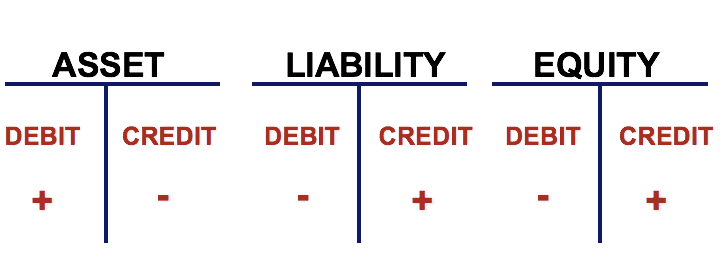

Dividends normal balance: A dividend is on the left side of the accounting equation and is normally a debit balance.Cost of goods sold normal balance: Cost of goods sold is an expense on the left side of the accounting equation and is normally a debit balance.Common stock normal balance: Common stock is part of capital on the right side of the accounting equation and is normally a credit balance.Cash normal balance: Cash is an asset on the left side of the accounting equation and is normally a debit balance.Accounts receivable normal balance: Accounts receivable is an asset on the left side of the accounting equation and is normally a debit balance.Accounts payable normal balance: Accounts payable is a liability on the right side of the accounting equation and is normally a credit balance.
#Debit credit table professional#
In actual fact, the bookkeeping records are only inwords, the professional term for each record being a " Journal Entry: (or a "journal voucher").To understand the concept of the normal balance consider the following examples in relation to the table above. An additional stage that should be emphasized is that the first part (the T - Accounts) in fact serve us as a draft for the purpose of illustrating the records.


The Cash Account is debited - according to Rule 2 in the table.Ĭomment: It is easy to remember that every expense account is debited (the expense is a negative matter from an economic point of view and it is a debt of the business).Similarly, all receipts are a credit (a credit is something positive from an economic point of view and it is to the credit of the business).

The Income from the Rental Account (a profit and loss account) is a credit - as all receipts are a credit (Rule 3 in the table). The Max Account (a personal account) is credited - according to Rules 1 or 2. The Store Account (a real account) is debited - the transaction received a monetary value (Rule 2 in the table). The Electricity Expenses - (A profit and loss account) is debited - as every expense account is debited (Rule 3 in the table). The Goods Account (a real account) is credited - because the warehouse issued goods (Rule 2 in the table). The Cash Account (a real account) is debited - because the cash was received (Rule 2 in the table) The Waterman Account, (a personal account) is credited - as it is due to receive money (Rule 2 in the table). The Goods Account (a real account) is debited - because an account was received (Rule 1 in the table). This will be explained more fully later on.ģ.1.xx Cash payment, Expenses Voucher 001 We will practice making the bookkeeping records that are the subject of the above table (Comment: In the first part of the solution, the records will be presented in the form of a T account, and they will be presented textually in the second part. 953).ĥ.ĕ,1,xx We rented the store out for $ 700 cash (Invoice No.001) 1950)ģ.ē.1.xx We paid $ 200 cash for electricity expenses (Expense Voucher 001).Ĥ.Ĕ.1.xx We bought a store from Max for $ 20,000 (Invoice No. 123).Ģ.Ē.1.xx We sold part of the goods for $ 600 cash (Receipt No. When the account gives us money/the equivalentĪny account that ends with the words 'Expense Accounts'.Īny account that ends with the words 'Revenue Account'ġ.đ.1.xx We bought goods from Waterman for an overall sum of $ 1,000 (Invoice No. When the account received money/the equivalent When the person in whose name the account is kept is in credit with us When the person whose in whose name the account is kept is in debt to us BOOKKEEPING COURSE: THE DEBIT AND CREDIT RULES


 0 kommentar(er)
0 kommentar(er)
